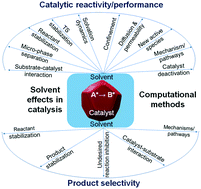当前位置:
X-MOL 学术
›
React. Chem. Eng.
›
论文详情
Our official English website, www.x-mol.net, welcomes your
feedback! (Note: you will need to create a separate account there.)
Origins of complex solvent effects on chemical reactivity and computational tools to investigate them: a review
Reaction Chemistry & Engineering ( IF 3.4 ) Pub Date : 2018-11-23 00:00:00 , DOI: 10.1039/c8re00226f Jithin John Varghese 1, 2, 3 , Samir H. Mushrif 4, 5, 6, 7
Reaction Chemistry & Engineering ( IF 3.4 ) Pub Date : 2018-11-23 00:00:00 , DOI: 10.1039/c8re00226f Jithin John Varghese 1, 2, 3 , Samir H. Mushrif 4, 5, 6, 7
Affiliation

|
Solvents are crucial components in specialty chemical and pharmaceutical industries and in electrochemical and photoelectrochemical processes, and are increasingly being used in catalytic reactions. Solvents significantly influence the kinetics and thermodynamics of reactions and can alter product selectivity markedly. While such solvent effects are observed routinely, identification of the root causes of such effects is less frequent. Solvents can influence reaction rates, conversion and product selectivity by 1) directly participating in the reaction steps and opening alternate reaction pathways, 2) competing with the reactant for interaction with the catalysts, 3) changing the relative stabilization of the reactant, the transition state (TS) and/or the product, 4) altering intra-pore diffusion characteristics in porous catalysts, 5) exhibiting entropic confinement effects altering free energy barriers of reactions, 6) changing the solubility of different components in the reaction mixture, and 7) inhibiting undesired reactions. Their indirect influences may be due to 1) changes brought on to active sites on catalysts and 2) altered structure/stability of catalysts. This article discusses these fundamental reasons behind observed solvent effects with suitable examples. Advances in computational chemistry have led to the development of multiple tools and techniques, considering solvents either as implicit or as explicit molecules, providing molecular insights into complex solvent effects in catalysis. This article provides an overview of some of these methods with suitable examples to demonstrate their application and potential. This mapping of the solvent effects and their origins is believed to aid in the rational selection of solvents for catalytic reactions. The description of the computational tools, their application and their potential is likely to encourage widespread use of these techniques to investigate solvent effects.
中文翻译:

复杂溶剂对化学反应性的影响及其研究工具:综述
溶剂是特种化学和制药行业以及电化学和光电化学过程中的关键组分,并且越来越多地用于催化反应中。溶剂会显着影响反应的动力学和热力学,并会显着改变产物的选择性。尽管通常观察到这种溶剂作用,但很少能确定这种作用的根本原因。溶剂可通过以下方式影响反应速率,转化率和产物选择性:1)直接参与反应步骤并打开替代反应路径; 2)与反应物竞争与催化剂的相互作用; 3)改变反应物的相对稳定性,过渡态(TS)和/或产品; 4)改变多孔催化剂中的孔内扩散特性,5)表现出熵限制作用,改变反应的自由能垒,6)改变反应混合物中不同组分的溶解度,和7)抑制不希望的反应。它们的间接影响可能是由于1)改变了催化剂活性位点和2)改变了催化剂的结构/稳定性。本文通过适当的示例讨论了观察到的溶剂效应背后的这些根本原因。计算化学的进步已导致开发了多种工具和技术,将溶剂视为隐式分子或显式分子,从而提供了对催化中复杂溶剂作用的分子认识。本文通过适当的示例概述了其中一些方法,以演示其应用和潜力。溶剂作用及其来源的这种映射被认为有助于合理地选择用于催化反应的溶剂。对计算工具,其应用及其潜力的描述可能会鼓励广泛使用这些技术来研究溶剂效应。
更新日期:2018-11-23
中文翻译:

复杂溶剂对化学反应性的影响及其研究工具:综述
溶剂是特种化学和制药行业以及电化学和光电化学过程中的关键组分,并且越来越多地用于催化反应中。溶剂会显着影响反应的动力学和热力学,并会显着改变产物的选择性。尽管通常观察到这种溶剂作用,但很少能确定这种作用的根本原因。溶剂可通过以下方式影响反应速率,转化率和产物选择性:1)直接参与反应步骤并打开替代反应路径; 2)与反应物竞争与催化剂的相互作用; 3)改变反应物的相对稳定性,过渡态(TS)和/或产品; 4)改变多孔催化剂中的孔内扩散特性,5)表现出熵限制作用,改变反应的自由能垒,6)改变反应混合物中不同组分的溶解度,和7)抑制不希望的反应。它们的间接影响可能是由于1)改变了催化剂活性位点和2)改变了催化剂的结构/稳定性。本文通过适当的示例讨论了观察到的溶剂效应背后的这些根本原因。计算化学的进步已导致开发了多种工具和技术,将溶剂视为隐式分子或显式分子,从而提供了对催化中复杂溶剂作用的分子认识。本文通过适当的示例概述了其中一些方法,以演示其应用和潜力。溶剂作用及其来源的这种映射被认为有助于合理地选择用于催化反应的溶剂。对计算工具,其应用及其潜力的描述可能会鼓励广泛使用这些技术来研究溶剂效应。











































 京公网安备 11010802027423号
京公网安备 11010802027423号